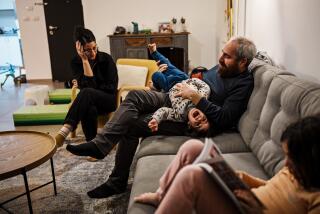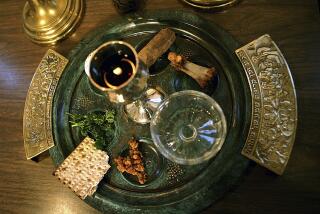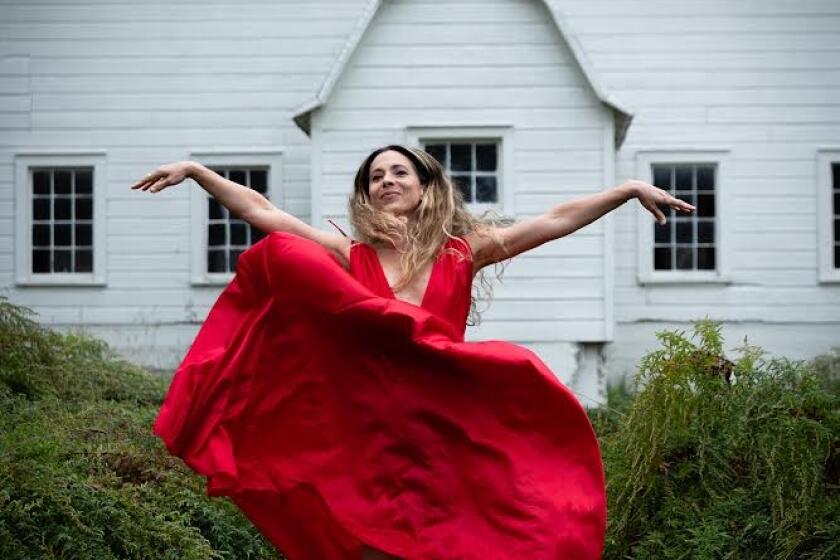Personalizing the Passover Seder
As Jewish families and their friends gather this evening for Seder, the ritual meal that marks the Passover celebration, the events they commemorate need no added drama. The Passover story itself has plenty of that.
It tells how Moses and the Israelites, enslaved in Egypt, learned of God’s plan to rescue them. On the night of their escape, families gathered for a meal prepared in such haste that there was no time for the bread dough to rise.
The secret departure incurred Pharaoh’s angry pursuit, until his army drowned in a mysterious crossing of the Red Sea. Into the desert, on toward the Promised Land and sweet freedom the Israelites went, hopeful about their future. The final words spoken at the Seder promise, “Next year in Jerusalem.”
The annual ritual that recalls this centerpiece of Jewish history has become as much a celebration of Jews’ individuality as of their shared heritage.
Certain elements of the Passover ritual remain firmly set in Tradition. Symbolic foods--the matzo, bitter herbs, the paschal lamb and kosher wine--are faithfully preserved. So is the retelling of the biblical story of the escape from slavery that is laid out in the Haggadah, the book of sacred readings and instructions used for the Seder. Still, there is room to personalize the celebration, and many Angelenos do.
“ ‘Haggadah’ means ‘telling,’ ” explains Rabbi Gary Greenebaum, director of the American Jewish Committee. “As with all storytelling around the world, this story will evolve.”
Elie M. Gindi, a doctor and father of three, is one thoroughly modern parent who used ingenuity to involve his kids in the ancient tale.
He customized the Haggadah to make his children, ages 11, 8 and 5, active players in the drama. His book contains photos of them dressed as ancient Israelites, along with children’s songs and prayers easy enough for them to understand. He also included the sacred texts written in Hebrew, as well as reproductions from older Haggadahs he especially admires. His book blends the religious traditions with his own family’s customs.
“Passover was always a time when everybody in the family got together,” he says of his childhood. “I learned so much about the holiday, and about my religion each year.
“As a parent, the problem for me was that my kids were bored by the Seder. They thought it was too long. Traditionally, some parts of the ritual are held before the dinner and some are after. My kids never made it back for the second part.”
*
To produce his own Haggadah, Gindi reviewed some 400 others, including many that are currently available in stores. It took him nine months to complete the desktop printing project.
“It was a labor of love,” he says. Now he is making a slightly less personal version he hopes to publish.
Whatever helps capture the experience of a newfound freedom from oppression has a place in the Passover celebration. Gindi recalls how relatives once asked all the guests to dress in costume. They relived the flight into the desert as they walked on sand-scattered floors in the house.
Rabbi Richard Levy, executive director of the Los Angeles Hillel Council, an educational and cultural organization, published a traditional Haggadah, “On the Wings of Freedom,” in 1989.
He believes Jews individualize his Haggadah as well as others for a particular reason.
“Everyone should consider themselves as redeemed, and ask what it meant to be redeemed in Egypt, in the Middle Ages and in modern times,” he says. “Seder is an opportunity to work out those questions.”
Levy recalls one recent Seder where the children staged a magic show. They pulled frogs from the dinner glasses to recall the frogs that invaded Egypt as one of 10 plagues when Pharaoh refused to set Moses and his people free.
“It was wonderful, and then came the whole point of it. The plagues were not magic. They came from God. It was such a powerful lesson.”
*
As modern social issues such as racial equality and women’s rights have emerged, one host added a Martin Luther King Jr. speech to the evening’s events.
Greenebaum describes Haggadahs themed to economic justice, educational opportunities and the environment.
“Look at the nuclear specter and see how we are slaves to that,” he suggests. “Haggadahs introduce issues right off the latest headlines.”
Published Haggadahs range from the basic and traditional to the videotaped and interactive. Since 1932, Maxwell House coffee has provided a Haggadah on specially marked cans of coffee at this time of year. The company, a division of Kraft Foods, has distributed millions of them over the years.
“It is a way of connecting with loyal Jewish consumers,” says Pat Browne Riso, manager of communications for Kraft.
Gindi refers to a Haggadah as a blueprint. As more Jews adapted the basic formula to their own interests, there are a growing number of research sources. Hebrew Union College library in Los Angeles, open to the public, owns a collection of around 100 Haggadahs, including a facsimile of one from 19th century Vienna, and another from 17th century Venice.
“Many are named for a city where they were found,” says Harvey Horowitz, the head librarian.
America Online subscribers can research a variety of Haggadahs by typing in “Jewish Community” and clicking on “Holidays.”
“Passover Seder is unique in the sense that you include what is important to you,” says Gindi. “I want my kids to be there for the whole thing, and I want them to be involved.”
More to Read
Sign up for our Book Club newsletter
Get the latest news, events and more from the Los Angeles Times Book Club, and help us get L.A. reading and talking.
You may occasionally receive promotional content from the Los Angeles Times.









